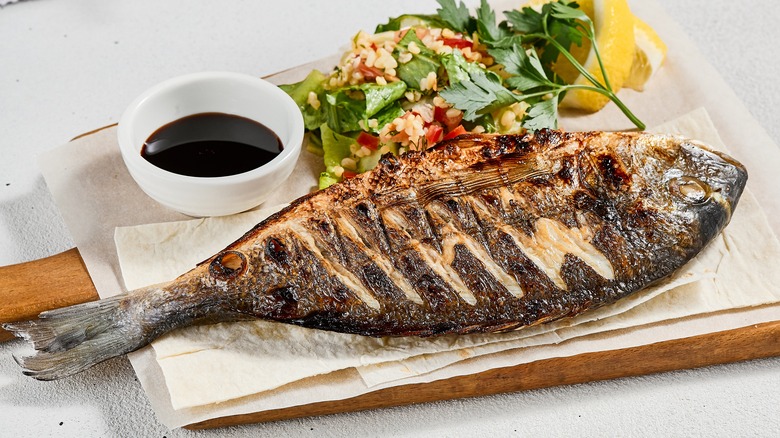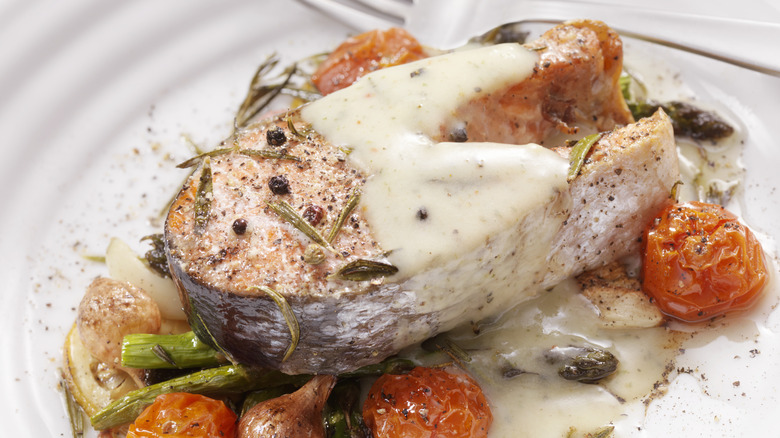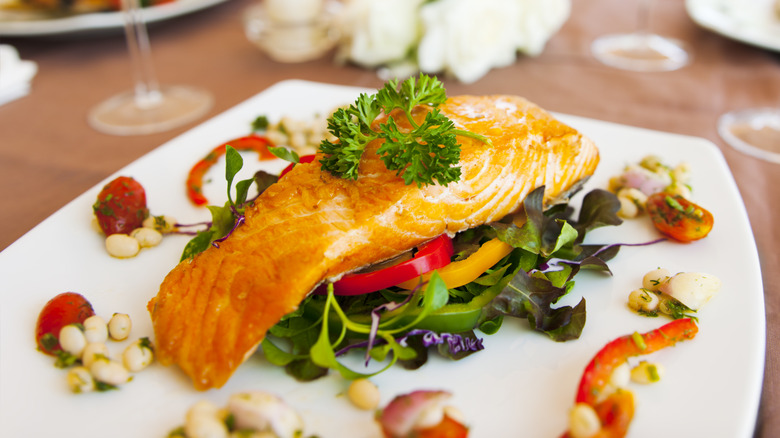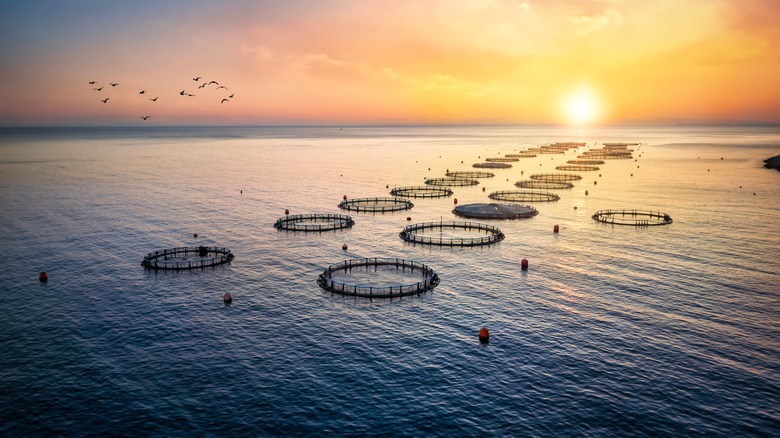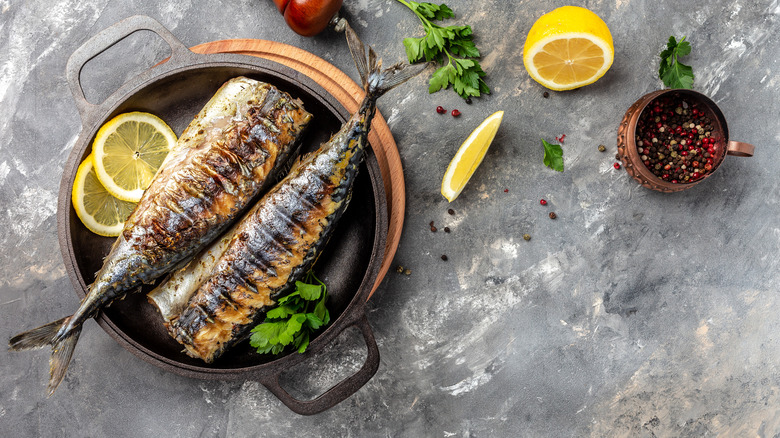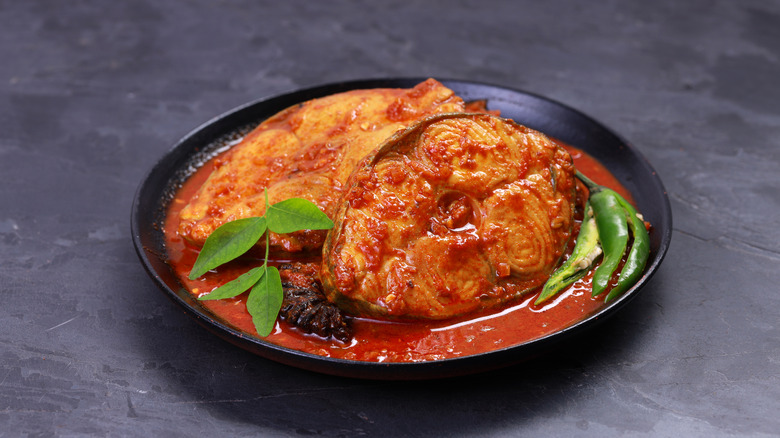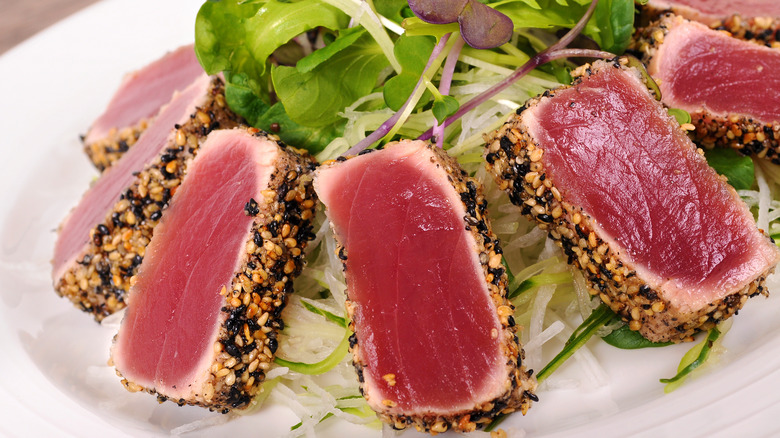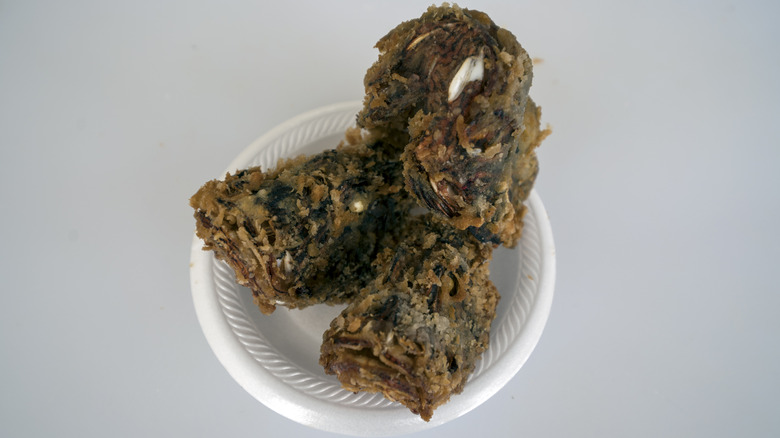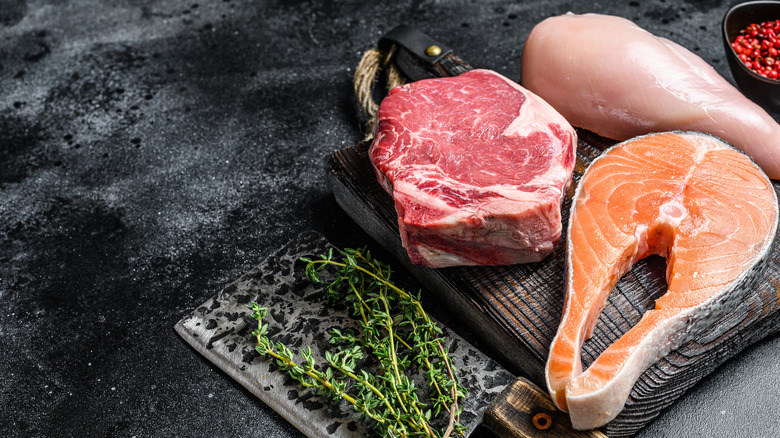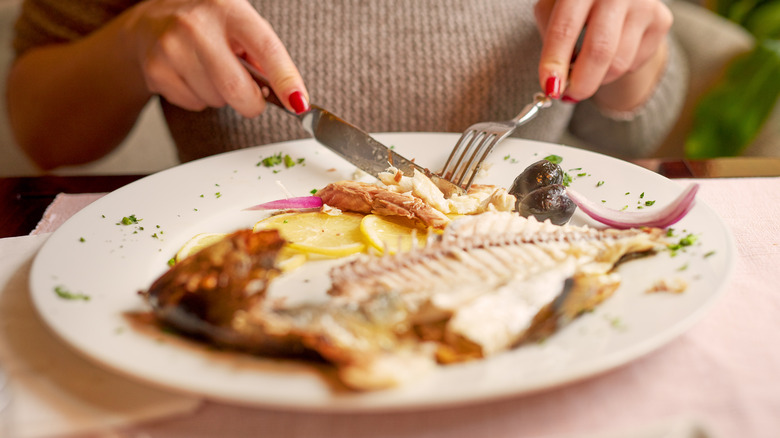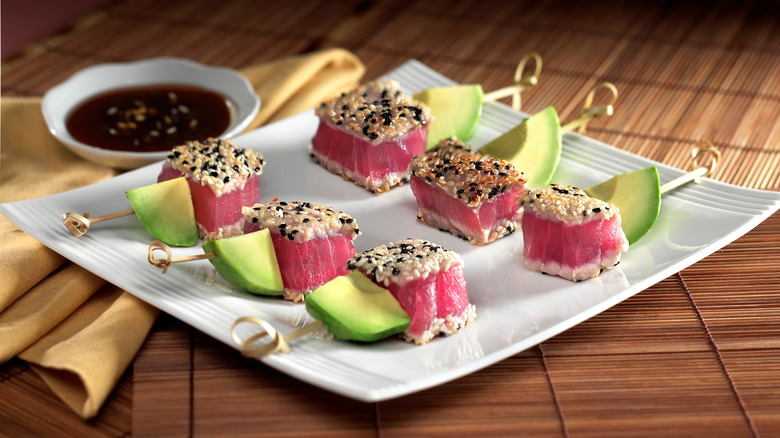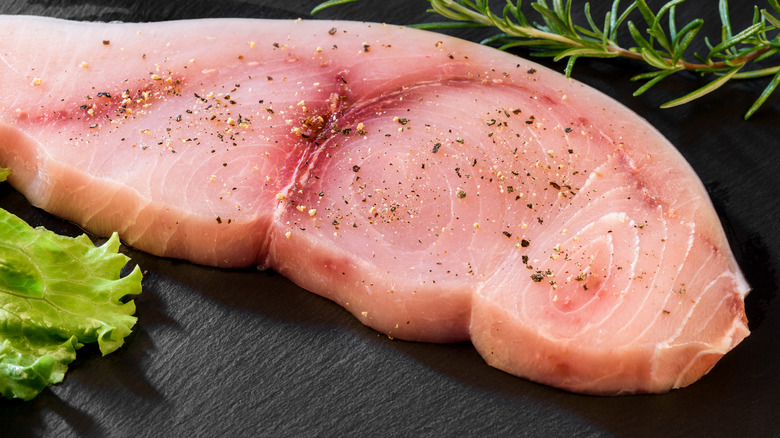13 Common Mistakes Everyone Makes When Ordering Fish
A well-cooked piece of fish is a thing of beauty — and if you want it done right, a restaurant's the place to be. While you can achieve perfectly seared fish at home, a well-trained chef has both the technique and the equipment to cook it to absolute perfection. Fish can be notoriously tricky, because it cooks so much quicker than other meat products. Moreover, most fish varieties have a delicacy and subtlety of flavor that requires a certain skill and knowledge to bring out in the best way possible. Going with a professional just makes sense.
For the uninitiated, though, ordering fish can be a slightly daunting experience. Luckily, there are certain things you can do to make your experience easier. Knowing what fish is in season, for example, and having a basic sense of what different types of fish taste like can help you get the freshest fillets that suit your palette. But what about the things you shouldn't do? Ordering fish can be a minefield, and beyond knowing your hake from your halibut, you also need to be aware of what mistakes to avoid when making your choice. Dive in with us as we check out the top fish ordering errors.
Ordering fish and dairy together
The debate over whether you can order fish with dairy is as old as time. Until there's a clear resolution on the matter, though, we would recommend avoiding the combination of the two. The main reason for this is that the flavors just don't go together. Cream-based or cheesy sauces tend to be thick, and this overwhelms the lightness and sea-tinged flavor of your fish.
As with anything in life, though, this isn't a hard and fast rule. The combination of dairy and fish is a fairly common one in Northern European cuisine, and you may well find fish dishes spiked with feta in a Greek restaurant. Generally, however, it's a flavor profile that's best avoided. Instead, experts recommend going for fish dishes centered around citrus flavors, with the astringency of lime and lemon and the gentle sweetness of orange working beautifully with light, tender fish flesh. Herb-based sauces can also be a great choice; the grassiness of parsley or dill or the slight spiciness of cilantro all work to elevate the fish.
Asking for fish on a Monday
If you're determined to get the best fish meal possible, ordering one on a Monday is a big no-no. This is especially an issue if you're dining in a place that isn't fish-focused, or which is especially far away from a coastline. Ordering fish on a Monday is a somewhat risky move due to the way that certain parts of the food industry, particularly fish markets, operate. Oftentimes, fish markets are open during certain weekdays and closed on the weekend. As such, by the time Monday rolls around, the produce could have been sitting in the restaurant's fridge for several days, gradually deteriorating in quality and potentially spoiling.
It's fair to point out, though, that ordering fish on a Monday used to be a far bigger issue. As we now live in a world of increasingly advanced food storage systems and 24-hour supply lines, it may well be the case that your restaurant has constant access to fresh fish, and there's no need to worry. For maximum freshness, though, you should always aim to order fish on a Tuesday or a Thursday, especially if the place you're eating in is a smaller operation.
Ordering your fish without checking its origins
The fish industry is fraught with long-standing sustainability issues. While awareness of these problems has increased, that doesn't necessarily mean that every fish meal in a restaurant is sustainable. That's why it's important to look out for indicators of your meal's origins. Acronyms like MSC (Marine Stewardship Council) or (Aquaculture Stewardship Council) on the menu next to the produce can indicate that the fish used has been certified as sustainable. Logos on the restaurant's website or their menus from the Soil Association or the Sustainable Restaurant Association (or SRA) can also show the eatery's commitment to sustainable food, including seafood.
You should also watch out for certain buzzwords that might make your fish seem like it's more sustainable than it truly is. "Wild" or "local" fish options may look attractive, but they don't mean that the fish has been caught or reared sustainably. If in doubt, it's always best to ask the manager at the restaurant about the origins of the fish. If there's any uncertainty about whether it's sustainable or not, it may be better to choose something else.
Asking to change the cooking style
Here's the thing, folks: Different fishes are prepared in different ways for a reason. The reason, we're keen to stress, is usually to make your experience better. So rolling into a restaurant and asking for your grilled salmon to be deep-fried is not only going to annoy your server and the kitchen staff, it's also going to ruin your meal.
Rather than commit this faux pas, keep in mind that the way each type of fish on the menu is prepared is done so because it's the best method for it. Trout, swordfish, and salmon, for example, all have a meatier taste and slightly more dense flesh. This makes them perfect for roasting, grilling, or pan-searing, but less suitable for deep-frying. On the other hand, flaky fish like cod or haddock are arguably at their best when they're coated in batter and fried in oil, but when they're put on the grill, they have a knack for falling apart. It's always best to roll with whatever the restaurant is offering, remembering that the menu has been designed by a professional, so you don't feel like you've wasted your money.
Ordering the fish special
Specials in restaurants have a certain allure. The chance to have something unique that isn't normally on the menu ... Sounds great, right? It does — until you think about why the special is there in the first place. "Specials are tricky in restaurants. It could be the most fresh and delicious special, but in some restaurants, specials are the way to clean up the fridge," warns chef Silvia Barban, per Business Insider. This is an issue with any style of food, but when it comes to seafood and fish, which tend to go off way quicker than other proteins ... well, what you could be presented with is a three-day-old fillet that tastes like it should have been thrown out yesterday.
There are certain exceptions to this, however. If it's an on-menu special that's available all month, it might be the case that the restaurant is merely trying to honor seasonal produce, which makes this an opportunity to grab something extra fresh. Promotional specials that stem from partnerships with other food producers, as a way to drive business for both parties or highlight specific ingredients, may also be safe. If, however, the menu is hastily chalked on the front board at the last minute, you should probably order from the main selection.
Forgetting that some fish is served rare
For some people, the very idea of fish that's not entirely cooked through may strike a bolt of fear directly to the heart. However, before you send that order back, remember that it could be more delicious than you think. Certain types of fish, like tuna and salmon, are frequently served rare, with a nice brown sear on the outside and some pinkness in the middle. Not only is this safe (although it should be pointed out that it's never totally risk-free to consume raw fish, and cooking it through is always safer), it can also give your meal a new lease on life, presenting you with a flavor and texture contrast that's out of this world.
Understandably, though, not everyone will like the thought of their fish still being raw in the middle. So, if you're concerned, you should always ask for it to be cooked through or medium-done. If ordering tuna, it's best not to ask for it to be well-done, as this can cause the fish to become dry and rubbery. Luckily, it's normally the case that your server will ask you how you like your fish cooked, so there's no need to worry too much if you're eyeing up these types of fish on the menu.
Being unadventurous with your fish choices
Fish can be fairly frightening, even for folks who eat it regularly. So we can understand why you might lean away from the more out-there options on the menu and stick with basic white fillets. Unfortunately, we consider this a mistake that prevents you from having some of the most delicious options out there, tailor-made by a professional chef who understands how to use the ingredients properly.
Remember, too, that certain types of fish may sound scary, but are not that different from more familiar ones. Lionfish, for instance, has white flesh that's often compared to snapper or grouper, despite looking very different on the outside. Sea urchins, meanwhile, might look threatening, but under their spines, sweet, salty flesh is concealed. Anchovies, when bought in the supermarket, may carry a rusty appearance (and a delicious flavor packed with umami), but when ordered in a restaurant, these tiny fish are mild and lightly salty. While you don't have to pick something different just because it's there, it could open up your palate in new, surprising ways.
Ordering fish and red meat together
One of the joys of eating with a friend is being able to share two dishes that you can't decide between. If those two dishes are fish and red meat, though, we would recommend you pick one or the other. The problem with pairing fish with red meat like lamb or beef is that their flavors completely clash. Take lamb, for instance: This deeply savory meat has a gamey undertone and a dense, rich flavor throughout, and is most commonly paired with other intense flavors like red wine or cumin. This is not a natural pairing for white fish like cod, which tastes mild, delicate, and ever-so-slightly sea-like, tending to go well with zesty flavors like lemon or orange.
It may be the case that you can get away with ordering fish as an appetizer and red meat as a main, if there's enough time between the two courses. Ordering fish after a red meat appetizer, on the other hand, may serve as a palate cleanser. Ordering them together, though? That's a mistake you won't want to make.
Failing to check how it's prepared
Some menus are super explicit about how your food is made — and others are less willing to share. While that element of not knowing what you're getting can be quite fun, in the case of fish, you should always be checking how it's cooked. A deep-fried cod fillet will taste completely different from a poached one, with the former being salty, fatty, and covered in batter or breading, and the latter gently cooked, flaky, and with a subtle flavor. Both of these, in turn, will taste different from a pan-seared fillet, which will have a smokiness and a slight hint of caramelization to it.
How your fish is prepared will also affect how it's served, as well as what kind of flavors and textures are used in the recipe. Moreover, a difference in preparation styles can significantly affect the nutritional value of a meal, which may be a consideration for folks who are looking to avoid too much fat or certain ingredients. It may also impact how filling a meal is, and what you choose to order alongside it, or beforehand as an appetizer (or even afterwards as a dessert).
Asking for certain types of fish
While you might love the taste of catfish or tilapia, you may want to avoid ordering them in a restaurant. Certain types of fish can be completely misbranded as something else. Take catfish, for example, which may not be catfish at all. There's a longstanding issue of swai, a type of South Asian catfish, being branded as catfish in the United States, a practice that may incur a fine from the USDA. While the two may taste and look similar, swai is often produced without being regulated properly, and as such may be at higher risk of contamination.
Tilapia, on the other hand, has become one of the most popular fishes around the world — but its nutritional profile may not be what you expect. While fish is usually praised for being healthy and nutritious, tilapia has a high ratio of omega-6 fatty acids, and has been linked to higher levels of inflammation. This can be an issue for certain individuals who are trying to follow a heart-healthy diet and can be exacerbated even more by certain cooking styles, like frying in fat.
Choosing fish at a steakhouse
If you follow a pescatarian diet, eating out can be hard. So it can seem like salvation to see a fish option on a meat-heavy menu — but we would heavily recommend steering clear of it if possible, or picking another restaurant for your fish needs. Restaurants that specialize in meat may offer fish as an alternative, but the majority of their expertise will likely be spent elsewhere, making that fish course an afterthought. While you'll probably get something edible, you might not get something good.
It's also worth thinking about where the restaurant you're eating is on the map. "Do not order crab or crabcakes from restaurants not located on the coast," says executive chef Steve Chiappetti (per All Recipes), and we would argue this extends to fish too. Although your fish may have gotten there in totally sanitary conditions, you're never going to get the same experience as eating freshly caught fish directly in the harbor. You might want to save the money you would have spent on that fish course for the next time you're near the sea.
Only ordering fish from the entrée menu
The idea of choosing a fish course as an appetizer can be, for some reason, pretty weird. Maybe it's because the thought of taking a plump, moist fillet of fish and breaking it down into smaller pieces or combining it with other ingredients can seem like sacrilege to some. However, opting for a fish appetizer can be a light way to start your meal, with the vibrant, sprightly taste of fish awakening your taste buds for a richer entrée course.
While shrimp is a staple of appetizer menus, it also pays to look elsewhere. Ordering smoked salmon as an appetizer allows you to revel in the deep, complex flavors of the dish while still eating something relatively light. Mini fish cakes, meanwhile, can be an instant crowd-pleaser, and whet your appetite for what's to come. Fish kabobs, such as those made from tuna, give you a protein-forward start to your meal, and allow the flavor of the fish to sit front and center, enabling you to enjoy some (hopefully) well-sourced produce. If you'll excuse the seafood-related pun: The world's your oyster.
Forgetting about mercury levels
Ordering fish is not without risk, and mercury content can be the most concerning thing about certain types. Fish species like King mackerel, swordfish, and shark are particularly high in mercury. Most adults should only be eating one portion of these types of fish per week, while pregnant people or those who are trying to conceive should avoid eating them entirely, regardless of whether they're made in a restaurant or served at home.
The consequences of consuming too much mercury are not to be sniffed at. Mercury is a neurotoxin that can affect motor function; weakness, sensory difficulties, trouble moving, and loss of coordination are all symptoms of mercury poisoning. Generally, though, if you're not exhibiting any signs of mercury overexposure, you should be okay. If you're concerned about your mercury levels, you may be better off ordering low-mercury fish like salmon, cod, sardines, or seafood like scallops or shrimp. Yellowfin and albacore tuna, carp, and grouper are medium-mercury choices that should be okay to eat a few times a week.
